Durango GT gives Dodge alternative to Jeep
By John Gilbert
Jeeps continue to be a dominant force for FCA (Fiat-Chrysler Automobiles), and seem to expand to fill every niche while becoming just about all things to any customer. But if it’s all-wheel drive that makes Jeeps so popular, there are FCA offerings from Dodge to supplement the choices for all-wheel-drive customers.
Logical alternatives range from prominent to obscure. Most prominent among Dodge’s “other” stable is the Durango, which has been streamlined from a larger and bulkier SUV to a sleeker shape with a much-improved interior.
The Durango test vehicle came to me as a Durango GT AWD, an attractive and a little bit sinister when painted Granite Metallic, with a fair amount of black trim. The fact that it came with Chrysler’s redoubtable 3.6-liter Pentastar V6 24-valve engine and an 8-speed automatic with full-time all-wheel drive made me think it was pretty much a Grand Cherokee living in a parallel world in Dodge clothing.
At $40,000 base price the test Durango tallied $48,765, reflecting the full-boat options of GT trim. In Northern Minnesota January, it was a solid performer for traction and power.
The other Dodge vehicle that can get you through a Northern winter on a lighter and less-expensive scale is the Dodge Journey, which does a surprisingly good job of portraying a combination SUV and minivan, in Crossroad livery.
Journeys have a chance at much better fuel economy with the 2.4-liter 4-cylinder. but also can be bought with the 3.6-liter Pentastar V6 and 6-speed automatic transmission. While the Journey can come in front-wheel or all-wheel drive, it has a much more limited tow capacity (1,000-2,500 depending on engine), which is also understandable.
The Journey doesn’t have the Durango’s stylish flair, but it also costs less — $29,595 in base form for the Journey Crossroad Plus AWD, and $34,360 well-equipped.
The 2017 Durango GT is smooth on the highway and can get 21 or 22 miles per gallon in freeway cruising, although the EPA estimated 25 mpg highway seems a bit high.
Exterior styling is properly macho for Dodge, and it includes the grille-headlight-foglight array in front, and a rear that will surprise you the first time you see it at night. There is a flashy LED outline around the taillights that connects in a manner suggesting it is a road-racing circuit somewhere. It is a definite signature touch that Dodge has also used on the Challenger and Charger sporty models of recent years.
Inside, the front buckets are comfortable and firmly supported, and I was disappointed at first to find the audio system lacked a CD player, but then I opened the console and found a CD player mounted vertically on one edge.
The rear buckets have their own personality as well, flanking a large floor-level console for rear occupants, located right behind a control-filled panel between the front seats .
The rear buckets also drop down at the touch of a switch and fold flat, with a strap to allow flip-up treatment that lets occupants easily hop into the third-row rear bench seat.
Dodge also made use of its brilliant minivan trick by arranging to have the second-row buckets tumble away if folding flat doesn’t sufficiently add to your interior room and versatility.
Another feature I liked was that when the rear seat headrests stick up too high and you’d like more visibility out of your rear-view mirror, you can flick a switch and the headrests fold forward to eliminate blocking the visibility.
The transmission is shifted by a rotating knob on the console, and it worked flawlessly for us. An 8-speed automatic is a smooth-shifting unit, and if it seems too tame, you can shift with steering wheel paddles.
Heated front and second-row seats are a welcome touch, as is the heated steering wheel, although it takes a few tries to figure out how to stop it from heating up every time you start.
While we had recently had some wintry weather in Northern Minnesota, the Durango GT’s term with us was in moderate 35-42 temperature, with snow melting down steadily, but creating some slippery situations on top of what seemed like a glacial deposit from recent cold.
It didn’t matter, because the Durango was steady and precise in all circumstances. The GT adds some interior refinement, with red stitching, and soft-touch paneling on the dashboard, plus anodized gunmetal trim accents.
Dodge also has pretty well perfected the connectivity thing, with smartphones readily connected to the Uconnect system. A hefty 506-watt amplifier on the Beats audio system was impressive too. The navigation system, and power sunroof and tailgate worked well, as did the park assist, rear camera, lane assist, and such appreciated features as autostart and auto-dimming headlights.
A rear video system with screens folding down from the backs of the front buckets, complete with a DVD system and are compatible with BlueRay discs that we never got a chance to try out, but would be a travel-worthy feature for any family with kids.
Load-leveling suspension, as well as headlight leveling and a rugged towing capacity of 6,200 pounds gives the Durango GT the credentials to haul a trailer as well as a family. The 3.6 is the base engine in the Durango, and you could go up to the 5.7 Hemi V8 if you need to boost towing up to 7,400 pounds.
The Durango is a highlight vehicle for Dodge, and pretty well does everything you might want a Jeep Grand Cherokee to do, with the exception of the variable terrain controls in the Jeep.
More obscure is the Journey, which I had driven extensively last summer, a welcome reminder that Dodge was still making the useful “tweener” SUV. Now that the 2017s are rolling in, again I was unsure that the Journey would make the cut. It did, indeed.
The 4-cylinder model has 173 horsepower and 166 foot-pounds of torque, and can get pretty good fuel economy. The test Journey with its meaner looking grille and front aluminum bumper-guard had the 3.6 V6 and it measures 16 mpg city and 24 highway — less than the 18-25 of the larger and heftier Durango.
The Journey has many attributes, including tumble and hide rear buckets, straight out of the Caravan. The in-floor storage bins easily accommodate the disappearing rear buckets, creating more of a versatile hauling space.
The same back-up camera and park assist system is in place, and black leather seats set off the bright red exterior of the test vehicle. All in all, the Journey Crossroad Plus, fully loaded, is a lighter and more compact version of the Durango, and gives FCA customers at Dodge dealerships plenty of options to choose from.
A Jeep by any other name might be available from Dodge.




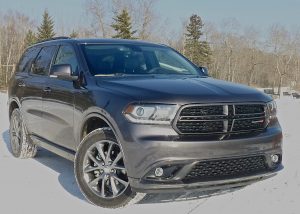
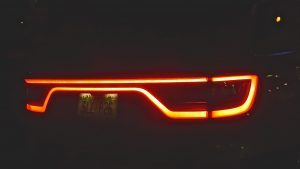
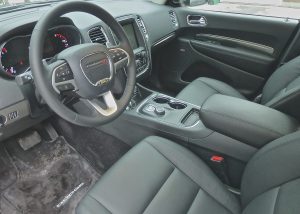
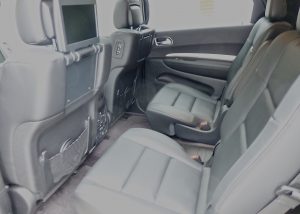
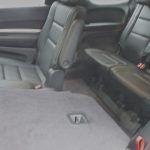
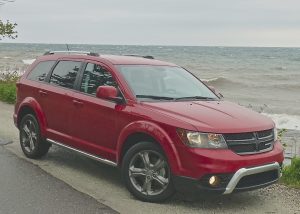
 John Gilbert is a lifetime Minnesotan and career journalist, specializing in cars and sports during and since spending 30 years at the Minneapolis Tribune, now the Star Tribune. More recently, he has continued translating the high-tech world of autos and sharing his passionate insights as a freelance writer/photographer/broadcaster. A member of the prestigious North American Car and Truck of the Year jury since 1993. John can be heard Monday-Friday from 9-11am on 610 KDAL(www.kdal610.com) on the "John Gilbert Show," and writes a column in the Duluth Reader.
John Gilbert is a lifetime Minnesotan and career journalist, specializing in cars and sports during and since spending 30 years at the Minneapolis Tribune, now the Star Tribune. More recently, he has continued translating the high-tech world of autos and sharing his passionate insights as a freelance writer/photographer/broadcaster. A member of the prestigious North American Car and Truck of the Year jury since 1993. John can be heard Monday-Friday from 9-11am on 610 KDAL(www.kdal610.com) on the "John Gilbert Show," and writes a column in the Duluth Reader.